Indiana’s Small Business Snapshot
Since helping small businesses has been in the news recently, let’s take a look at Indiana’s makeup of small establishments. Before proceeding, it is important to note that the definition of a small business varies. Depending on the industry, the Small Business Administration (SBA) defines small business in terms of either the number of employees or the average annual receipts. Where employment is used as the measure, often establishments with up to 500 employees fit the small business definition (especially where the manufacturing sector is concerned), and even up to 1,500 employees in a very limited number of cases.1
For the purposes of this article, we will focus on the smallest establishments in Indiana from the employment perspective—those with fewer than 20 employees. Ongoing research by the Indiana Business Research Center has found that the share of establishments with fewer than 20 employees relative to the total number of workers in the region had a positive and significant influence on gross domestic product per worker.2 Therefore, these establishments are worth a closer look.
How Many?
In all, Indiana had 152,858 establishments in 2007, with 129,258 of those being small businesses (defined here as having fewer than 20 employees). This ranked Indiana 18th among states and the District of Columbia in the sheer number of small businesses (see Figure 1).
Figure 1: Number of Small Business Establishments, 2007
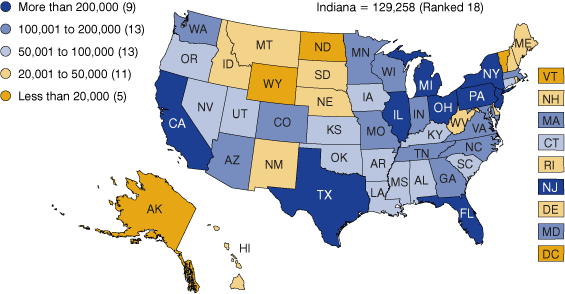
Note: A small business is defined as having fewer than 20 employees
Source: IBRC, using U.S. Census Bureau County Business Patterns
In 2007, 84.6 percent of all Indiana’s establishments were small businesses (with one to 20 employees), employing nearly 632,000 people (that’s 24 percent of all workers). About half of all small businesses in Indiana employed four or fewer people, another 20 percent of those establishments employed five to 10 people, and about 14 percent employed 10 to 19 people. Compared to the United States, Indiana had a higher proportion of establishments in every size class except businesses with one to four employees (see Figure 2).
Figure 2: Percent of All Establishments by Number of Employees in Indiana and the United States, 2007
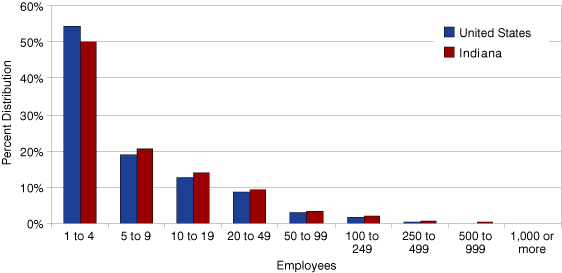
Source: IBRC, using U.S. Census Bureau County Business Patterns
Which Industries?
Of the small businesses in Indiana, the retail trade industry had the most establishments (right at 20,000 establishments). Other services (including such industries as repair and maintenance; personal and laundry services; and religious, grant-making, civic, professional, and similar organizations) also make up a relatively large portion of small business in Indiana, with 12.5 percent of all small businesses in the state. Construction has the third highest number of small businesses, with more than 14,800 establishments.
Overall, the distribution of small businesses across industry sectors in Indiana was not so different from the United States, though a few industries stand out. Retail trade establishments had a higher percentage in Indiana than the United States. On the other hand, higher-paying industries such as finance and professional, scientific and technical services had higher proportions of establishments in the United States than in Indiana (see Figure 3).
Figure 3: Percent of Small Businesses by Industry, 2007
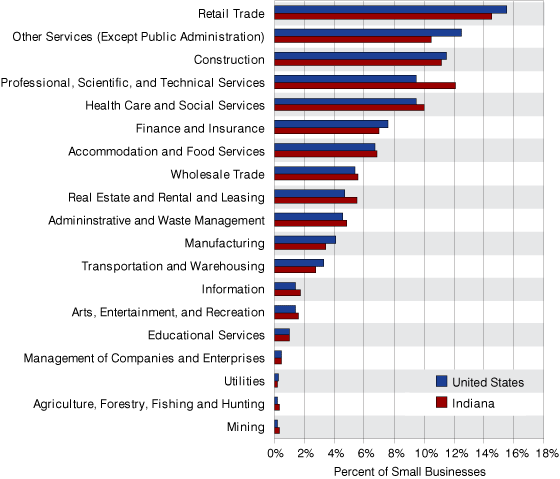
Source: IBRC, using U.S. Census Bureau County Business Patterns
How Big Is the Payroll?
How do these small businesses fare in terms of economic activity? The annual payroll of all businesses with less than 20 employees in Indiana added up to $18.8 billion in 2007. This total averaged out to about $29,825 per small business employee. Across the United States, average annual payroll for small business employees was $35,485 in 2007.
What about the Self-Employed?
Not included in the establishment data above are data about self-employed people with no employees on the payroll (known as nonemployer establishments). There are nearly two and a half times as many of these self-employed establishments (379,813 establishments) as there are total establishments with a payroll. Indiana’s number of nonemployer establishments ranked the state 21st nationally and seventh among its Midwestern neighbors (see Figure 4).
Figure 4: Number of Nonemployer Establishments in Midwestern States, 2007
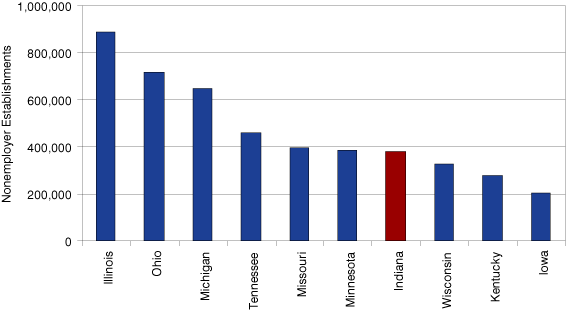
Source: IBRC, using U.S. Census Bureau data
Other services, construction and retail trade were the three industries with the highest proportion of establishments with no employees. Nationally, retail trade barely made the top five for establishments with no employees, being outdone by professional, scientific and technical services; other services; construction; and real estate (see Figure 5).
Figure 5: Nonemployer Establishments by Industry as a Percent of Total Nonemployer Establishments, 2007
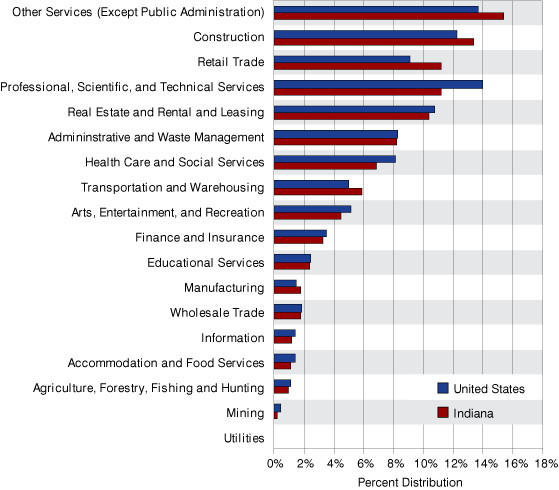
Source: IBRC, using U.S. Census Bureau County Business Patterns
The average receipts per nonemployer establishment in Indiana were $37,915, compared to U.S. receipts of $45,688 per establishment. 3 This trend held true across all major industry sectors (see Figure 6).
Figure 6: Receipts per Nonemployer Establishment in Indiana and the United States, 2007
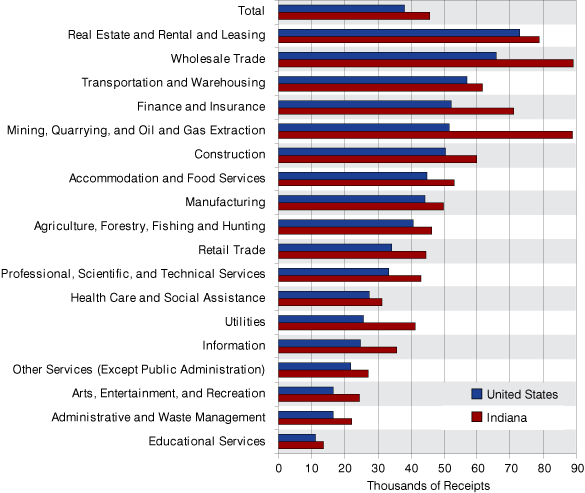
Source: IBRC, using U.S. Census Bureau County Business Patterns
Learn More
About 24 percent of Hoosier workers are employed by small businesses with fewer than 20 people, making it a vital part of the economy. For additional information on small businesses in your ZIP code, county, or metro, visit the Census Bureau’s County Business Patterns page at www.census.gov/econ/cbp/.
Notes
- www.sba.gov/contracting/getting-started-contractor/make-sure-you-meet-sba-size-standards/table-small-business-size-standards
- Visit www.statsamerica.org/innovation/innovation_index/research.html for more information on this research, which was made possible by a grant from the U.S. Economic Development Administration.
- This includes gross receipts, sales, commissions, and income from trades and businesses, as reported on annual business income tax returns. Business income consists of all payments received for services rendered by nonemployer businesses, such as payments received as independent agents and contractors.
Molly Manns
Associate Editor, Indiana Business Research Center, Indiana University's Kelley School of Business
